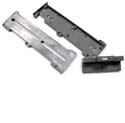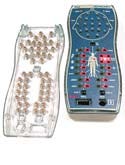July 6, 2003
Originally Published MPMN July 2003
PROFILE
Getting the Lead Out
Rapid tooling process speeds CT equipment upgrade
|
A resin supplied by RTP Co. can be used to replace lead parts in numerous applications. |
The relatively low cost of lead has made it a key component in many products, including some medical devices. The element has a well-known downside, however: It has been proven not only toxic to humans but also damaging to electronic equipment.
It was for these reasons that device OEM Philips Medical Systems (Cleveland;www.medical.philips.com) sought to replace the lead components in its computed tomography (CT) systems. "The electronic parts [located near the x-ray tube] in the CT scanner would see a lot of radiation," says Peter Kozelj, senior mechanical engineer for Philips Medical. The component used to collimate the beam was close to the radiation source, and therefore would benefit from shielding.
To solve this problem, Philips had to overcome two hurdles. The first task was to find a suitable replacement material. "The U.S. military developed a composite made of nylon polymer mixed with tungsten powder to make bullets to reduce the amount of lead they were shooting into the environment," says Kozelj. This type of resin was selected for the prototype.
Next, Philips needed to find a technique that would allow for a short lead time. Injection molding was too costly, according to Kozelj. Enter Catalyst PDG Inc. (Indianapolis; www.catalystpdg.com) and its Sample Time Acceleration Technology (STAT).
STAT is a hybrid of composite and traditional tooling technologies developed by Catalyst. This technique yields a plastic part in just days. A standard master unit die can take weeks.
|
STAT rapid tooling technology developed by Catalyst PDG was used in the development of this sleep apnea device. |
With the players in position, Philips Medical set a number of parameters for this fast-paced project. The parts had to be delivered in 10 days. The tooling and molding cost had to be lower than casting lead. In addition, the resin had to meet the same specifications as lead, and the parts had to meet EPA guidelines.
Using the STAT system, Catalyst built the three required tools in five days. The composite material then went through a four-step proprietary tempering process. This treatment ensures that the material is able to withstand the heat and pressure of traditional presses.
|
STAT rapid tooling technology developed by Catalyst PDG was used in the development of this sleep apnea device. |
Problems arose when Catalyst could not get the high-density resin to fill out when molding the prototype parts. "The resin would not flow with a standard gate size," says Catalyst vice president and engineer Earl Dunlap. A relatively new material, the resin had not been tested previously, and Catalyst had five days left to come up with a solution. More prototype parts needed to be made in a short period of time.
By the ninth day of trial and error using the original resin, Catalyst contacted RTP Co. (Winona, MN; www.rtpcompany.com), a polymer and resin supplier. The RTP resin produced positive results. "Not too many people use this resin, so I've heard. Catalyst was one of the first to mold a more-complex shape from this composite material," saysKozelj.
"We normally don't make too many things in injection molding because of the tooling cost," says Kozelj. "We might do several thousand, not several million [parts], so the Catalyst process was perfect for what we needed. Even if the tooling wore out by the time we needed to make the parts, it is cheaper to do more tooling than [to rely on] standard injection molding," he adds. "That would cost 10 to 20 timesmore."
Copyright ©2003 Medical Product Manufacturing News
You May Also Like





